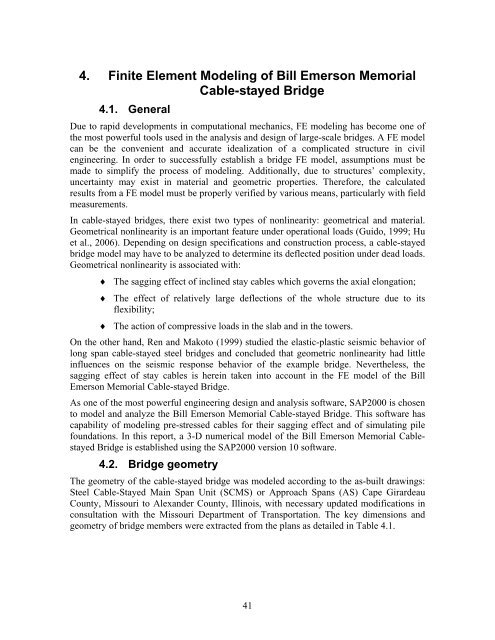Assessment of the Bill Emerson Memorial Bridge - FTP Directory ...
Assessment of the Bill Emerson Memorial Bridge - FTP Directory ...
Assessment of the Bill Emerson Memorial Bridge - FTP Directory ...
- No tags were found...
Create successful ePaper yourself
Turn your PDF publications into a flip-book with our unique Google optimized e-Paper software.
4. Finite Element Modeling <strong>of</strong> <strong>Bill</strong> <strong>Emerson</strong> <strong>Memorial</strong>Cable-stayed <strong>Bridge</strong>4.1. GeneralDue to rapid developments in computational mechanics, FE modeling has become one <strong>of</strong><strong>the</strong> most powerful tools used in <strong>the</strong> analysis and design <strong>of</strong> large-scale bridges. A FE modelcan be <strong>the</strong> convenient and accurate idealization <strong>of</strong> a complicated structure in civilengineering. In order to successfully establish a bridge FE model, assumptions must bemade to simplify <strong>the</strong> process <strong>of</strong> modeling. Additionally, due to structures’ complexity,uncertainty may exist in material and geometric properties. Therefore, <strong>the</strong> calculatedresults from a FE model must be properly verified by various means, particularly with fieldmeasurements.In cable-stayed bridges, <strong>the</strong>re exist two types <strong>of</strong> nonlinearity: geometrical and material.Geometrical nonlinearity is an important feature under operational loads (Guido, 1999; Huet al., 2006). Depending on design specifications and construction process, a cable-stayedbridge model may have to be analyzed to determine its deflected position under dead loads.Geometrical nonlinearity is associated with:♦ The sagging effect <strong>of</strong> inclined stay cables which governs <strong>the</strong> axial elongation;♦ The effect <strong>of</strong> relatively large deflections <strong>of</strong> <strong>the</strong> whole structure due to itsflexibility;♦ The action <strong>of</strong> compressive loads in <strong>the</strong> slab and in <strong>the</strong> towers.On <strong>the</strong> o<strong>the</strong>r hand, Ren and Makoto (1999) studied <strong>the</strong> elastic-plastic seismic behavior <strong>of</strong>long span cable-stayed steel bridges and concluded that geometric nonlinearity had littleinfluences on <strong>the</strong> seismic response behavior <strong>of</strong> <strong>the</strong> example bridge. Never<strong>the</strong>less, <strong>the</strong>sagging effect <strong>of</strong> stay cables is herein taken into account in <strong>the</strong> FE model <strong>of</strong> <strong>the</strong> <strong>Bill</strong><strong>Emerson</strong> <strong>Memorial</strong> Cable-stayed <strong>Bridge</strong>.As one <strong>of</strong> <strong>the</strong> most powerful engineering design and analysis s<strong>of</strong>tware, SAP2000 is chosento model and analyze <strong>the</strong> <strong>Bill</strong> <strong>Emerson</strong> <strong>Memorial</strong> Cable-stayed <strong>Bridge</strong>. This s<strong>of</strong>tware hascapability <strong>of</strong> modeling pre-stressed cables for <strong>the</strong>ir sagging effect and <strong>of</strong> simulating pilefoundations. In this report, a 3-D numerical model <strong>of</strong> <strong>the</strong> <strong>Bill</strong> <strong>Emerson</strong> <strong>Memorial</strong> Cablestayed<strong>Bridge</strong> is established using <strong>the</strong> SAP2000 version 10 s<strong>of</strong>tware.4.2. <strong>Bridge</strong> geometryThe geometry <strong>of</strong> <strong>the</strong> cable-stayed bridge was modeled according to <strong>the</strong> as-built drawings:Steel Cable-Stayed Main Span Unit (SCMS) or Approach Spans (AS) Cape GirardeauCounty, Missouri to Alexander County, Illinois, with necessary updated modifications inconsultation with <strong>the</strong> Missouri Department <strong>of</strong> Transportation. The key dimensions andgeometry <strong>of</strong> bridge members were extracted from <strong>the</strong> plans as detailed in Table 4.1.41
















